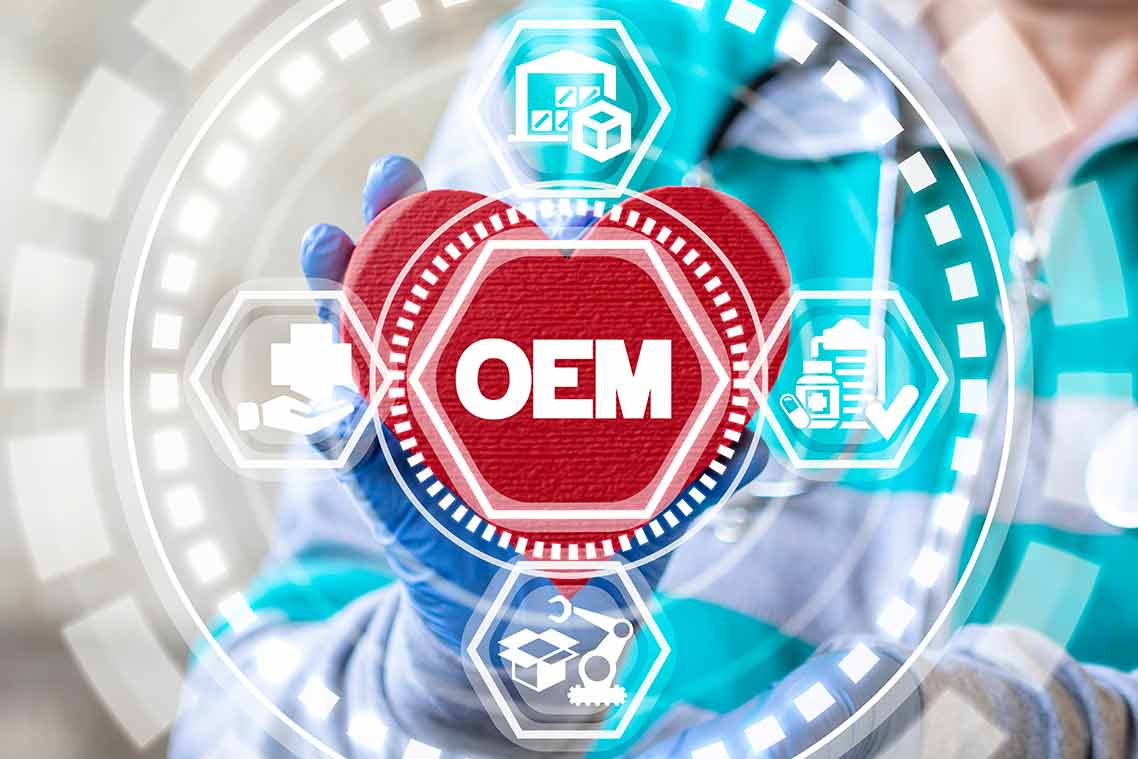
What Does OEM Mean and How Does It Work?
OEM, or original equipment manufacturer, is a term heard most often within two industries: automotive and IT. Initially, it was associated with a company that manufactured a product which was then resold or rebranded by another company. However, the meaning of this term has evolved over time, and today it refers to different things. For instance, OEM can reference a company that manufactures the actual components used by another company to build a whole system. In other instances, the company rebrands another company’s products and sells them to end-users.
OEM is also associated with the software industry. When PC-manufacturing companies such as Dell and HP build a PC, they provide the operating system (OS) to the end-user. This OS is not developed by the hardware company but is actually a product of another company, Microsoft. In this case, Microsoft is called the OEM, while the PC is sold as a Dell or HP.
How is an OEM Product Built, Partnered, and Resold?
Before delivering a solution to end-users, companies figure out the best way to serve customers’ needs. They evaluate several options such as whether to buy, manufacture, build, or partner with someone to design the solution. By partnering with OEMs, an organization can minimize the investment in manufacturing and reduce production and material costs while gaining expertise in product design as well as a shorter product life cycle. While concentrating on their core competency, organizations can still build products using best-of-breed components.
OEMs do nothing extra to the product, and some only brand a product with their logo. Other OEMs only supply components and do not sell anything under their brand. However, many companies do both. You can purchase these products from the company directly as well.
OEM in Hardware
In the hardware industry, the OEM usually refers to a company that builds a product designed for end-users, like a PC, laptop, or printer. Apple, HP, Dell, Canon, and Brother are all examples of original equipment manufacturers.
OEM hardware, on the other hand, is the term for parts that make up the products mentioned above. This includes processors, fans, motherboards, memory chips, hard drives, and much more. Companies who build these components usually sell them as OEM hardware to the OEMs.
Although processors, motherboards, and so on can also be sold to individuals as retail products, OEM hardware is generally cheaper than their retail counterparts. But there are some tradeoffs. OEM hardware rarely comes with customer support, has very short (if any) warranty periods, and usually lacks some parts needed to combine it with other components of whatever system you’re building. For example, DVD drives might lack cables or ribbons for connecting to the motherboard.
This is because OEM hardware is primarily designed for OEMs and those manufacturers are expected to add things like warranties, tech support, and other components when they build complete systems and sell them to end-users.
OEM in Software
An example of OEM in software is when manufacturers like HP, Dell, and Samsung purchase Windows as OEM software from Microsoft and then package it together with the PC or laptop they manufacture.
Companies that build other devices like printers, scanners, and digital cameras buy OEM software too. When you buy these devices, you’ll notice that they’re usually bundled with an accompanying application. That’s the OEM software.
Just like OEM hardware, some OEM software can be purchased as a standalone product—and as with OEM hardware, they’re usually much less expensive. But the downsides are also there. Often there’s no tech support or user manual. When you buy these OEM products, know that it’s going to be challenging once you encounter technical issues. Of course, if you really know what you’re doing, then that shouldn’t be a problem.
The Differences Between OEM and ODM
ODM is the acronym for ‘Original Design Manufacturer’. While ODMs do manufacture equipment, they rely on product specifications or designs coming from another company.
An OEM is free to produce equipment based on its own specification and designs, and the manufacturing equipment bears the brand name and logo of the OEM. On the other hand, ODMs must follow the design specified by the company that has outsourced manufacturing to the ODM. The manufactured equipment bears the brand name and logo of the outsourcing company instead of the ODM. The main advantage of ODMs is the low cost of production associated with outsourcing.
Why are OEM Products Less Expensive?
Products from an OEM are normally cheaper thanks to economies of scale. As the company partners with others to manufacture goods in large numbers, both the price and production time are significantly reduced. However, you need to verify what you’re getting when you purchase a product from an OEM. While the products are cheaper and deliver the same features and performance, you may not receive some of the “extras” like tech support, which would normally be handled by a PC company.
How Do OEM and Aftermarket Differ?
OEM is a company whose equipment, goods, or products are used in the products of other companies who sell the finished products to users. In the computer industry, OEM can be defined as a company that buys computing products, incorporates them into their products, or rebrands them into a new product for sale.
Aftermarket, on the other hand, is equipment, goods, or product made by another company that consumers can use as a replacement. It can hence be said that OEM and Aftermarket are the opposite of each other.
As an example, if a company ABC provides microcomputer chips to a computer manufacturer company DEF, then ABC is an OEM company. However, if ABC sells microcomputer chips similar to the ones manufactured by DEF, then ABC is an aftermarket company. Aftermarket products are usually cheaper and convenient to obtain.
Parallels RAS: A Turnkey All-in-One VDI Solution
Many businesses benefit from virtual desktop infrastructure (VDI) because it simplifies IT management, improves data security, allows remote access from any device, and saves money.
Parallels RAS is an all-in-one application delivery and VDI solution that enables users to work remotely from anywhere, on any device, at any time.
- Offers an all-in-one, cost-effective, and high-performing application delivery and VDI solution that allows access to virtual workspaces 24/7 from anywhere.
- Protects data from unauthorized access by centralizing, monitoring, and restricting access to applications and desktops.
- Enables implementation of bring-your-own-device (BYOD) and choose-your-own-device (CYOD) policies, digital workspaces, and flexible working.
- Provides reliable business continuity and accessibility by allowing them to leverage on-premises, hybrid, or public cloud deployments.
- Excellent user experience (UX) on any device, including tablets and mobile.
Download the Parallels RAS trial today and enhance your application and desktop delivery infrastructure!

